Bokken and Other Wooden Weapons Maintenance
Varnishing, oil polishing, storage, repair and quality standards
Proper maintenance and correct storage of wooden weapons is crucial for two reasons. The first and most important one: security. The second, no less important for the practitioner, is to prevent the weapon from deterioration and warping over time. It is also possible to "repair" a bent weapon to some extent. In this article, we will also talk about our quality standards and processes. You will find all the information you need in this article to take care of your Bokken, Jo, Tanto and other weapons.
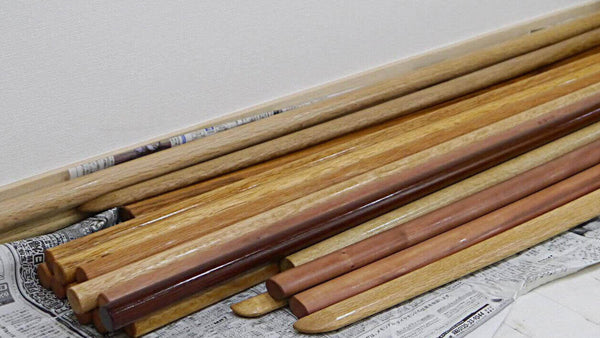
Polishing wooden weapons before shipment, at Seido
Security
Although this topic is addressed very early in the practice of Kendo, especially in the case of the Shinai that must be maintained very regularly to avoid any defect or even safety risk, the need to control one's weapons may seem less obvious to a great number of Aikido practitioners and other Budoka. Yet, poorly maintained weapons are the cause of injuries every year, and although this can be attributed to a lack of instruction, in the end, it is always the practitioner's fault.
A Bokken or Jo with splints must not be used, but must be sanded and oiled instead. If the weapon appears to have a structural defect (cracks etc.) it has to be thrown away, as this can not be repaired guaranteeing safe practice. The examination must be fairly thorough, the varnish or drying problems are hardly visible and often inside the wood, so the external appearance of a weapon can be very deceptive concerning its strength. A weapon that is not perfectly straight does not pose any particular safety problems, but should be inspected in detail as this may also indicate a bad aging of the wood.
Of course, if you practice without contact, there is little risk that your weapon will break during practice. However, if you practice with full contact, it is absolutely imperative to not use a cracked weapon. If the weapon were to break during practice, this would be particularly dangerous, and probably the practitioner's fault who used neglected equipment.
Maintenance of Varnished Weapons
If your weapon is varnished, it does not necessarily require regular maintenance. The urethane varnish applied on Japanese weapons is a thin and relatively colorless varnish, of which the main purpose is to protect the weapon from moisture and prevent it from bending, by plugging the pores of the wood cells.
After a few years of use, the varnish will gradually fade / flake off, and its protective power is no longer guaranteed. When you feel the need (it depends on the frequency of use, but also the amount of blows received by the Bokken), it will be necessary to sand the weapon and oil polish it. If the condition of the weapon looks really bad, you should repeat this step several times. The sanding and oiling will remove the damaged fibers and nourish the wood. It will be more difficult to sand the second and third time, a sign that indicates that the wood has densified and strengthened.
Beware of wooden weapons manufactured in Taiwan and other countries specializing in low-end products. Whether the Bokken is labeled "made in Taiwan / China" or "Japan Quality" (which does not mean that the Bokken is actually "made in Japan", but is an appellation used for weapons made in Taiwan that are of slightly higher quality), those weapons are varnished in general with a very thick and opaque varnish, sometimes even paint. Under this varnish it is very likely that the wood used is of poor quality and sanding/oiling these weapons may not be sufficient to make them usable again. In this case, it will be necessary to add a layer of varnish on top of it to avoid splinters, using a relatively thick varnish.

Varnish and maintenance oil for Bokken and Jo
Uncoated Weapons (crude, sometimes oil polished)
These weapons require very regular maintenance, especially to prevent them from warping, or the wood from deteriorating. We advise to oil the weapons once a month with vegetable oil (more nourishing for the wood than the mineral oil) of your preference. At SeidoShop, we are selling camellia oil, the same oil that is used by our artisans, but any vegetable oil will do (even olive oil is ok, if you do not mind the smell!).
How many layers? 1, 2 or 3 ... until the wood no longer absorbs the oil (allow the last layer to dry a few hours before wiping off the excess).
Conservation of Wooden Weapons
Wood is subject to the exchange of atmospheric moisture, which contracts and expands the fiber. This is what causes it to warp, so we recommend to be very careful when handling your weapons. It is imperative to store your weapons horizontally, in a ventilated room, not too wet nor too dry. It is therefore necessary to avoid cellars, garages, or humid place like the bathroom etc. Given the structure of most homes, in the bedroom (under the bed for example) is a good solution.
The temperature and humidity can vary significantly between floor and ceiling. Storing your weapons vertically means exposing the different parts of the weapon to different conditions. The wood close to the floor will absorb more moisture, and the fiber will swell, while the fiber on the tip will shrink. This will warp the weapon, until rendering it unusable. This is all the more true with non-varnished weapons, much more sensitive to external conditions (which explains the importance of saturating the wood in oil regularly). Note that the hands and skin generally secrete natural grease, thus protecting the handle of the Bokken more efficiently than the blade.

The next time you buy your Bokken and Jo from a shop, look at how they are stored! Even in Japan, a very significant percentage of weapons found in shops are warped.
In general, minimize the weapon's exposure to changes in humidity or temperature. Do not leave in the sun, near a stove and do not place it on a damped floor (outside, or in some Dojo).
Also pay attention to the transportation. It is not a problem to put your weapons against the wall in the locker room, however, the common mistake is to leave them in the trunk of the car in full sun. The temperature can rise rapidly, which is very likely to damage, even warp the weapons, over a relatively short period of time, a few hours can be enough.
Reparing a Bokken/Jo
Let's be honest: A cracked or fissured weapon cannot be repaired and should not be used for security reasons.
A weapon with slight "defects", irregularities or splitters can easily be sanded, that is not a problem. Warped weapons, slightly warped to be precise, can be straightened by using heat.
The opposite part of the curvature has to be put close to a flame so as to retract the fibers in the opposite direction of the curvature. It is a relatively simple process, but you have to know the wood well.
We therefore advise against doing it if you do not have particular knowledge in this field. On the other hand, most carpenters know about this technique and use it regularly. If you know a friendly craftsman, he can do this for you in five minutes.
You can also try to apply a heavy weight on the opposite side of the curvature for a few days. Although a bit difficult to apply, this works fairly well with red and white oak.
Also, we recommend to use a rather stout vise (with wood jaws if available) to hold the end of the weapon, then carefully bend the Bokken back, and in the opposite direction of the bending. If that is not enough, you can manage to apply a constant pressure for a few hours to a few days.
Paying Particular Attention to Weapons at Seido
As you know, we are passionate about Japanese martial arts, but also Japanese craftsmanship. In this respect, we particularly focus on weapons, pieces of art par excellence.
Thus, all weapons we receive are checked immediately when they arrive at our office. We control each weapon, one by one, at the level of its external appearance, and we verify that they are not warped. We also check their overall appearance, and although sometimes not very pretty, stains or other visible irregularities are quite normal in the framework of wooden craft.
Our weapons are stored horizontally, of course, in a room in which we strictly control temperature and humidity.
When a weapon is removed from the stock, it is checked again and once more when preparing it for an order.
All non-varnished weapons orders are oiled 3 times before shipment (and checked again if necessary), to avoid any problem in case of possible thermal shock during transport (especially in airplane bunkers) and further, we only use the fastest carriers for weapons, to ensure that they will not be stored for a long period of time in an unsuitable environment.
Although we do our very best, yes, it happened that we delivered a bent weapon, but this is very rare considering the amount of weapons we ship and we replace it, of course, immediately, if outside of our quality standards.

Wooden Weapon Storage at Seido
Our quality standards:
- A Jo mustn't be warped more than 1 mm (more than 50% of the production of all weapons in Japan present a very slight curvature, and there is nothing that can be done, as wood is a living material).
- Bo mustn't be warped more than 2 mm.
- Bokken mustn't be warped more than 0.5 mm.
- Standard weapons might present small structural weaknesses in the fiber at anywhere on the weapon, but deluxe weapons should not present any weakness on the entire blade part.
- No cracks on any weapon.
We believe we have the strictest quality standard of the industry, and we stand for it!
About the weapon's color, weight, and matching wood grain:
With every year, the wood availability decreases. Our craftsmen used to be able to match them all: quality, color, and weight to create "perfect weapons".
This is no longer possible at any workshop (and Seido is well positioned to say that, as we are the only company working with all workshops simultaneously), so we prioritize structural quality, over weight, and weight over color.
This means that there can be important color differences among the weapons. Dark white oak that looks the same as fair colored red oak, yellowish white oak, and the Isu no Ki can range from light pink to dark brown, etc. We accept specific requests, and we try to match colors for weapons sold as set, but it became very rare that we can perfectly match a full set. This is especially true for unvarnished weapons, as we do not know what they will look like once oiled.
Weight comes second, and we have noticed that weight can significantly vary, from minus to plus 10% of the average weight. Here again, as we have large stock quantities, we accept specific requests that we are usually able to fulfill, but this is not as easy as you might think. Where we do not compromise on, never, is the wood's structural quality and our very strict standards pushed us to sort out about 10% of the production.

Wood color variation for varnish/unvarnished weapons
About Asymmetry or Irregularity:
Asymmetry or Irregularity - Fukinsei (不均整) is the idea of controlling balance in a composition via irregularity and asymmetry is a central principle of the Zen aesthetic.
The Enso ("Zen circle") in brush painting, for example, is often drawn as an incomplete circle, symbolizing the imperfection as part of all existence.
More generally, every Japanese craftsmen makes a point in creating small asymmetry in their entire production.
In the case of a Bokken, a strong asymmetry might be an issue when using the weapon, so the asymmetry is usually located where it causes the least impact (beveled part for example).
The small imperfections created via asymmetry is also considered a very important thing in some old Koryu as it forces the practitioner to feel and become one with his own sword and apprehend the small differences among the swords. This trains the practitioner to be more adaptive to different weapons.

Asymmetry on a Katori Shinto Ryu Bokken

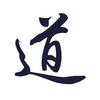
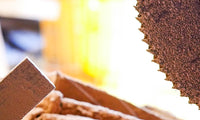
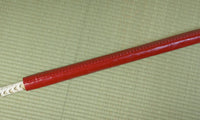
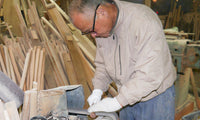
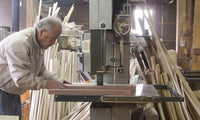
![Bokken+Jo+Tanto (with bag) [Aikido Set]](http://www.seidoshop.com/cdn/shop/products/Start-Set-01-en_240x240.progressive.jpg?v=1567385877)
![Standard Bokken & Shoto [Daisho Set]](http://www.seidoshop.com/cdn/shop/products/standard-daisho-set-01_en_30cfc956-3c2a-4ecd-ab3b-576b2c9c2383_240x240.progressive.jpg?v=1625119930)
![Deluxe Bokken & Shoto [Daisho Set]](http://www.seidoshop.com/cdn/shop/products/deluxe-daisho-set-01_en_240x240.progressive.jpg?v=1680152874)
![Deluxe Bokken, Jo & Tanto [Aikido Set]](http://www.seidoshop.com/cdn/shop/products/Akagashi-deluxe-01-en_240x240.progressive.jpg?v=1646278289)

![Iwama Ryu Bokken, Jo & Tanto [Aikido Set]](http://www.seidoshop.com/cdn/shop/files/Iwama-ryu-set-shirakashi-01-en_240x240.progressive.jpg?v=1719993179)
![Niten Ichi Ryu Bokken & Shoto [Daisho Set]](http://www.seidoshop.com/cdn/shop/products/Niten-ichi-ryu-set-01_en_5ed8b2e2-13f4-4052-9528-8ff92abbe639_240x240.progressive.jpg?v=1633483385)
![Yagyu Shinkage Ryu Bokken & Shoto [Daisho Set]](http://www.seidoshop.com/cdn/shop/files/Yagyu-Shinkage-Ryu-set_01_en_240x240.progressive.jpg?v=1695798511)
![Ono-Ha Itto Ryu Bokken & Shoto [Daisho Set]](http://www.seidoshop.com/cdn/shop/files/Ono-HaittoRyu_01_en_6944586f-03c8-4992-8fcf-9c44a366742e_240x240.progressive.jpg?v=1699412461)
![Katori Shinto Ryu Bokken & Shoto (Aramaki Model) [Daisho Set]](http://www.seidoshop.com/cdn/shop/files/Katori-Shinto-Ryu-set-aramaki-01-en_89bf21de-36c4-490e-b02b-357c71a7414f_240x240.progressive.jpg?v=1709164884)
12 comments - Bokken & Other Wooden Weapons Maintenance
I have an unusual question about cleaning a bokken. I have a white oak bokken with seido special finish, and one of our cats somehow managed to vomit on part of it. I’ve wiped off the vomit, but those spots on the bokken still feel somewhat rough. Shall I just sand these and then re-oil, or is there a way to try cleaning something semi-liquid off of this wood?
Dear Seido,
I have just used your invaluable tutorial to sand and oil both of my (now especially precious) bokuto.
One is a Yagyu style in red oak purchased almost 40 years ago and the other is Katori Shinto Ryu in white oak obtained when I visited the late Otake Sensei 18 years ago.
As I was working on them, I noticed that both have the same maker’s mark on the butt end of the tsuka – the outline of an 8 petal flower containing a large cross (+).
I wondered if you would be kind enough to tell me which manufacturer this represents?
Many thanks in advance!
Simon
Domo Arigato! That was a great explanation on wooden weapon’s maintenance! It was most informative and useful!
Hi Tim,
Yes, indeed, it should lie flat.
Now, it can be flat into a weapon bag, in a room with not too much humidity, and that’s good.
So weapons should lie flat on there side on a flat surface? Like on a table or in some sort of case off the ground? I want to make sure my bokkens last a long time so I can hand them down to my boys.
@Tan
The varnish is a clear non glossy urethane varnish. Very classic.
@Edgar
For such request, please drop us an email with the presentation of the website you would like to publish the article on. We’ll get back to you within 24h.
Hello everybody, Iam Edgar Montoya, I ask your permission to Translate your articles in a Facebook Group of martial arts named “ninjas & samurái cultura oriental en habla hispana” we have more than 24 thousand members, the First idea is about all english text in English Translate to spanish for the people, what do you think? Thank you.
I have an uncoated weapon and is wondering if I should use lacquer or varnish and if I should get glossy or satin kind? please give me some advice thank you!
hi, may I know what kind of finish( e.g. glossy, satin, semi-gloss…)is used for the varnish?
Ola, pergunta: estou lendo que também se usa verniz em alguns acabamentos. O verniz nao atrapalha na pegada da arma? Eu uso oleo de tungue, ou cera incolor, nunca uso verniz, pois pode grudar demais a mao no tsuka. É correto o que falo?
Hi Yung,
There’s only one thing to do: sandpaper!
You should be able to clean it up with a #400 or a #250 grain.
You’ll then have to chose between revarnishing (you’ll find urethan based varnish spray in any DIY store), or oiling it.
How would you remove paint stains on an unvarnished bokken? We did attacker/defender drills and my partner had a bokken that was painted black. Now mine has black stains all over the blade where we made contact.